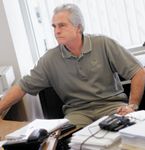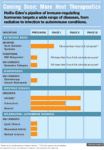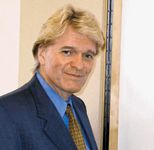It's All About Immunity
In a non-human primate study, high doses of Neumune resulted in 90 percent survival against a lethal level of radiation.
Cutting edge
One of the greatest threats
the United States faces is the detonation of a dirty bomb that spews radiation for miles and makes millions of people deathly ill. And yet this is the one disaster the country is least prepared to handle. An emergency preparedness guide issued by the city of New York says, "In the
unlikely
event of radiation exposure, the City
may
distribute KI [potassium iodide]."
It's not much of a plan, especially considering that potassium iodide only protects the body from developing thyroid cancer after exposure to radioactive iodine. Other types of high-level radiation exposure cause much more immediate damage. (See "Blast to Bone Marrow") The US military—on the front lines of such an attack—had been searching for a compound that will protect bone marrow against radiation damage for 50 years. Following 9/11, it stepped up efforts and finally found a solution.

Richard Hollis, founder and CEO of Hollis-Eden, thinks immunology is key to creating a world without disease.
While sifting through the mass of immunology literature produced by university and pharma researchers, the Armed Forces Radiobiology Research Institute (AFRRI) came across an immune-regulating hormone that looked interesting. The institute created a batch of the compound and began testing it in animals. The results were quite dramatic: Nearly all the mice that had been given the hormone, then exposed to lethal does of radiation, survived.
AFRRI soon learned that the patent for the compound, HE2100, was held by the San Diego company Hollis-Eden, which had recently turned its focus to bioterrorism. The two organizations entered into a collaborative agreement and fast-tracked the development of Neumune, the eventual brand name for compound HE2100, with the goal of producing an FDA approved drug that the US government could stockpile for treating acute radiation sickness (ARS).

Christopher Reading, PhD, a cellular immunologist, is Hollis-Eden's executive vice president of scientific development and led the initial work on the DHEA compounds.
The joint effort is a serendipitous by-product of 9/11. Before then, Hollis-Eden was just another small pharma company, engaged in a long struggle to find the right "first market" for its exciting immune-regulating technology.
Finding Focus
In 1994, when Richard Hollis turned 40—after a long career in pharma sales and marketing—his present to himself was launching his own company. "When I left the industry, I had the financial capacity to go out and license some technology and avoid venture capital," he says. "So with a little pocket of gold—not much, just a little bit—I went searching for technology to build a company on. The important thing was to have a good discretionary eye for technology that can really manifest into real medical products."
Hollis focused his search on immunology, an area he saw as the key to treating global infectious diseases. "I found a class of hormones that had some very interesting properties," he says. "The literature was four to five decades old, and I found it very intriguing that Big Pharma had not picked up these hormones." During the 60s and 70s, those companies developed corticosteroid hormones and sex hormones, leaving the immune-regulating group alone. But Hollis thought this group of steroid hormones—all active metabolites of the dietary supplement dehydroepiandrosterone (DHEA)—was "ripe for opportunity."

Blast to Bone Marrow
For a few years, he and his fledgling company struggled to understand the hormones and how they work in the body. In keeping with his quest to conquer global infections, Hollis targeted the research at HIV, tuberculosis, and malaria. (The Eden half of Hollis-Eden is not a silent partner, but the promise of a world with no disease.) In 1998, Hollis hired Chris Reading, a cellular immunologist, to sort through the company's science program and come up with a plan.
Around that time, the world-health community began pressuring the industry for free AIDS drugs, and compulsory licensing threatened global profits for companies making and developing AIDS medicines. Hollis decided that, financially, AIDS was not an ideal first target. But he also was convinced that long term, anti-retrovirals, which focus on killing the pathogen and are subject to resistance, were not the best answer. He kept his company and its research focused on host therapeutics, medicines that strengthen the body's immune system in its fight against disease. Then 9/11 happened, and the company shifted its first-to-market strategy to respond to the new demand for anti-bioterrorism products.

Coming Soon: More Host Therapeutics
Breaking Ground
The path to market for drugs that will be used to combat bioterrorist attacks is unique. Since scientists obviously cannot expose large groups of humans to deadly levels of radiation to prove that their drug will keep them alive, they must rely on animal models to prove efficacy. The approval of the BioShield legislation in mid- 2004, which allocated $5.6 billion and allowed an expedited process for anti-bioterrorism products, was a boon to Neumune's development. Hollis-Eden marked some impressive milestones in the last eight months.
"We were able to demonstrate survivability in non-human primates against lethal doses of radiation," Hollis says. "That was a very big issue for us, because FDA wanted us to have a clear endpoint. Since we were using the 'animal rule' they didn't want a surrogate marker, because we were already using a surrogate model. So we had to develop a model to demonstrate that we could show survivability as an end point in lethal doses of radiation. That's never been done before."

Dwight Stickney, vice president of medical affairs and practicing radiation oncologist, leads Hollis-Eden's development of Neumune, for acute radiation sickness.
The company tested Neumune in 40 Rhesus monkeys, with another 40 as a control group. The 40 animals that received the drug were given one of three doses, with the highest doses showing the highest level of efficacy—90 percent survival. In a meta analysis of all lethal studies reported to date, the mortality rate in the control group was 32.5 percent vs. only 12.5 percent in the treated animals. In these initial lethal (and in previous non-lethal) studies, Neumune therapy also provided statistically significant improvement in the recovery of neutrophils, platelets, and red blood cells—all essential in preventing radiation sickness.
Dwight Stickney, Hollis-Eden's vice president of medical affairs, explains: "We have two models. The first looks at the kinetics of the bone marrow and the repopulation of these cells that are effective in clotting and infection. We used that model without intending to do any lethality. After we optimized what we felt was a good formulation and a good dosage, we then developed the lethal model at the request of FDA. We did several experiments and proved that Neumune was quite effective without any medical supportive therapy. We went from forty-five percent of the animals dying to ten percent of the animals dying."
In early April, in the Netherlands, Hollis-Eden began its first Phase I safety and pharmacokinetic study of the drug in humans. Information from the study will be used to match the concentration in human plasma with that needed for efficacy in non-human primates for the final efficacy study. The company expects to file an investigational new drug application by mid 2005 and submit a new drug application in 2006. It also began manufacturing scale-up activities and is prepared to start shipping commercial quantities under the Emergency Use Authorization regulation by mid 2005.
All-Purpose Applications
Acute radiation is just the first of many indications that Hollis-Eden plans to pursue. The money earned from the US government's purchase of Neumune stockpiles will fund a host of other studies for other indications and pipeline projects. "We have lots of indications and opportunities," Hollis says. "Investors are buying into autoimmune disorders and infectious diseases. And the chemotherapy market is huge for us."
How can one group of compounds do it all? By targeting the signaling pathways of the immune system, improving endocrine and dendritic cell production, and stimulating immune response. "In HIV and cancer, the dendritic cells almost disappear," Redding says. "If you can restore those dendritic cells, we believe that is the reason we are able to improve cell-mediated immunity or the ability to fight HIV. We can begin to do the same thing in cancer."
Other companies are in competition to bring new autoimmune drugs to the market, but Hollis-Eden believes its compounds will be significantly more effective because they decrease inflammation and increase overall immunity without leading to immunosuppression. The current corticosteroids on the market that are widely used in autoimmune disorders often lead to immune suppression and bone loss. And TNF alpha drugs, which shut down one part of the inflammation response, can cause serious side effects. Hollis-Eden's compounds stimulate immunity instead of suppressing it, and have the ability to stimulate bone growth instead of leading to bone loss.
Partnership/Pipeline
Last year, Hollis-Eden acquired Congressional Pharmaceutical Corp. (CPC), along with the rights to a series of compounds that have the potential to protect against DNA mutations from radiation exposure or chemotherapy. The lead candidate in the group is Phosphonol, which the company hopes will also be developed in collaboration with the US government and given an expedited FDA review as an anti-bioterrorism product.
Also in development is Immunitin [HE2000], another immune-regulating hormone, which has shown in Phase II trials in Africa that it can reduce opportunistic infections in late-stage AIDS patients. The product has also shown potential in combating tuberculosis and malaria, and Hollis-Eden is in active talks with governments and nonprofit healthcare organizations around the world about collaborating on commercialization. The company also recently entered into collaboration with the Cystic Fibrosis (CF) Foundation to test the drug against CF.
Summing up the company's research and hopes for the future, Hollis says, "We are finding out that HIV and cancer and aging have many similarities. At the bottom of all three, there is disregulation and inflammation of the immune system. If these hormones can re-regulate them back to homeostasis and allow the body to respond like it did when it was in a healthy state, we may have a big breakthrough here in medicine."

Is Artificial Intelligence a ‘Product’? Products Liability Implications for AI-Based Products
April 10th 2025As the physical products we use evolve to become increasingly complex, traditional products liability frameworks may not always fit to provide remedies for harm that can result from using novel product types.